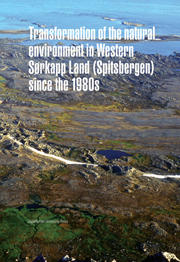Vegetation changes
from Conclusions and prognosis for environmental change
Published online by Cambridge University Press: 05 September 2014
Summary
On the basis of tundra vegetation mapping repeated after 25 years, major changes in the structure of several plant communities and their extent were recorded. First of all, a decrease in species diversity is visible, leading to more homogenous vegetation. This process is more noticeable in dry areas, whereas in wet areas, the changes are smaller. One of the most spectacular changes was a complete degradation of the fruticose ground lichen population, mainly in the Flavocetraria nivalis – Cladonia rangiferina community.
It seems necessary to try to predict the direction of future vegetation changes in Sørkapp Land. It is probable that the reindeer population in western Sørkapp Land will not decrease over the next few years. Climate change scenarios indicate a high probability of further warming of the climate.
The results of research from other parts of the Arctic can provide necessary information for estimating future changes. It is assumed that in the areas grazed by reindeer, graminoids usually increase (Elvebakk 1997). This is also true in lichen-dominated plant communities (Klein 1968; Post, Klein 1999) and they are also predicted to increase under global warming scenarios (Walker et al. 2006). On the other hand, macrolichens, although important for the functioning and biodiversity of cold northern ecosystems, are predicted to be negatively affected by climate change (Cornelissen et al. 2001).
- Type
- Chapter
- Information
- Transformation of the Natural Environment in Western Sorkapp Land (Spitsbergen) since the 1980s , pp. 87 - 88Publisher: Jagiellonian University PressPrint publication year: 2011



